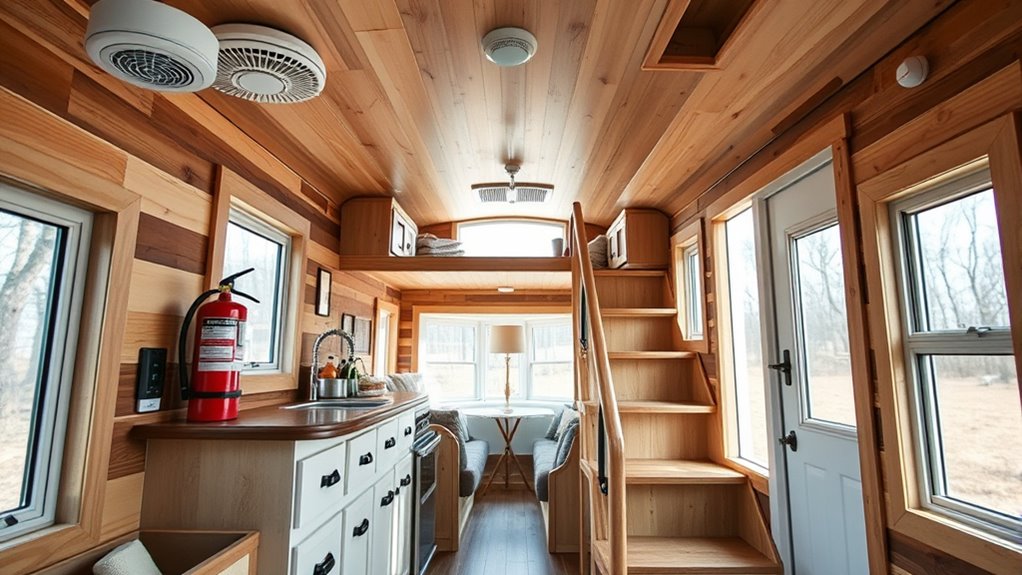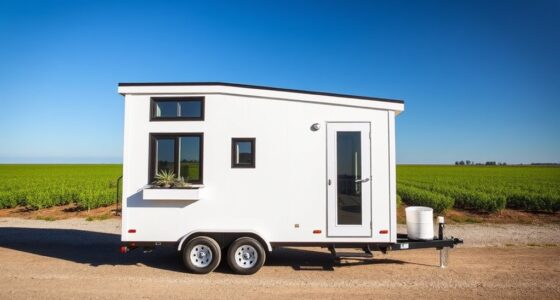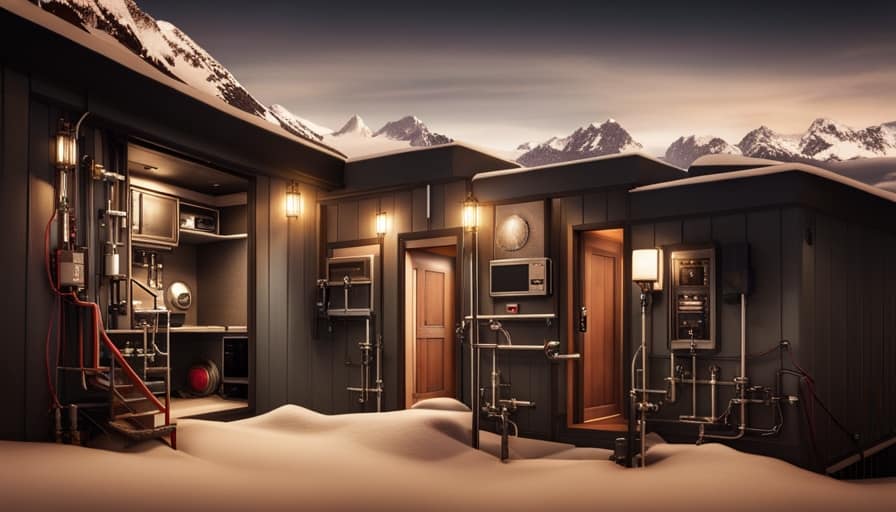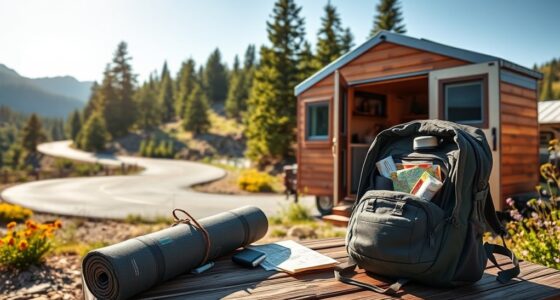To stay safe in your tiny house on wheels, regularly check your fire safety devices, like smoke and carbon monoxide detectors, and keep a fire extinguisher nearby. Inspect the trailer, axles, and wheels for damage, and tighten all fasteners periodically. Guarantee your electrical and plumbing systems are secure and in good condition. Don’t forget to prepare an emergency plan and store supplies. Keep your space safe. Continue exploring to discover essential safety tips you might be overlooking.
Key Takeaways
- Install and regularly test smoke and carbon monoxide detectors in key areas.
- Conduct routine inspections of trailer, axles, and wheels for damage or wear.
- Keep fire extinguishers accessible and rated for all fire types, especially in the kitchen.
- Secure all loose items inside before travel to prevent injuries and damage.
- Develop and practice an emergency plan, including nearby hospital locations and safety procedures.

Living in a tiny house on wheels offers mobility and simplicity, but it also requires careful safety measures to guarantee your well-being on the road. One of the most critical aspects is ensuring fire prevention. Tiny homes are compact, making the risk of fire potentially more dangerous if not managed properly. You should install smoke detectors and carbon monoxide alarms in key areas like the kitchen and sleeping spaces, checking their batteries regularly. Keep a fire extinguisher nearby, preferably in the kitchen, and ensure it’s rated for all types of fires. Avoid overloading electrical outlets and use appliances that are compatible with your electrical system to prevent sparks or shorts. Be cautious with space heaters and portable stoves, never leaving them unattended while in use. Maintaining good ventilation also helps reduce fire hazards by dispersing fumes and heat effectively. Recognizing the importance of emotional manipulation and other narcissistic behaviors can be crucial when dealing with difficult relationships, ensuring you stay safe emotionally and physically.
Equally important is maintaining the structural integrity of your tiny house. Since your home is mobile, it faces unique stresses from travel and weather, making it essential to regularly inspect and reinforce its structure. Check the trailer frame, axles, and wheels for signs of wear or damage, as these are critical for safe transport. Tighten bolts, nuts, and fasteners periodically to prevent loosening over time. Inspect the walls, roof, and foundation for cracks or leaks, which can weaken your home’s stability and lead to more serious issues down the line. Reinforce weak spots with appropriate materials, especially around windows, doors, and joints, to prevent structural failure during travel. Properly sealing and insulating your tiny house also protects against moisture, which can compromise your home’s framing and lead to mold growth.
In addition to these measures, it’s essential to keep your entire home well-maintained. This includes checking your electrical system for frayed wires or outdated components, and ensuring your plumbing is secure and leak-free. Keeping a detailed inspection schedule helps catch small problems before they escalate. When traveling, secure all loose items inside to prevent injuries or damage during transit. Also, remember that safety isn’t just about physical measures; having an emergency plan, including knowing the locations of nearby hospitals and keeping emergency supplies on hand, adds an extra layer of security.
Frequently Asked Questions
How Often Should Safety Inspections Be Performed on a Tiny House on Wheels?
You should perform safety inspections on your tiny house on wheels at least once every three to six months. Regular inspection frequency helps identify potential issues early and guarantees your safety audit intervals are maintained. During these inspections, check for structural integrity, electrical systems, plumbing, and fire safety measures. Staying consistent with these safety audits keeps your tiny home secure, compliant, and ready for trouble-free travel or living.
What Are the Legal Requirements for Towing a Tiny House on Wheels?
You need to check your trailer weight to guarantee it stays within legal limits for towing. Obtain the necessary legal permits, which vary by state or country, before hitting the road. Make sure your tiny house on wheels complies with local regulations, including weight restrictions and lighting requirements. Staying informed about these legal requirements helps you avoid fines and ensures a safe, hassle-free journey.
How Can I Prevent Fire Hazards in a Tiny House on Wheels?
Imagine you’re cooking in your tiny house when a small fire starts. To prevent this, guarantee fire extinguisher placement is easily accessible in key areas like the kitchen. Regularly check electrical wiring safety by avoiding overloaded outlets and inspecting for frayed cords. Keep a fire extinguisher nearby, and maintain clear escape routes. These precautions help you respond quickly and minimize fire hazards, keeping your tiny house safe.
What Safety Equipment Is Essential for Tiny House on Wheels Living?
You should prioritize safety equipment like portable smoke detectors and a fire extinguisher for your tiny house on wheels. Portable smoke detectors alert you to potential fires early, giving you time to react. A fire extinguisher helps you quickly put out small fires before they escalate. Keep these items accessible and regularly check their functionality to guarantee you’re prepared for emergencies while living in your tiny home.
Are There Specific Insurance Considerations for Tiny House on Wheels?
Think of insuring your tiny house on wheels like securing a safety net—they’re unique, so standard policies might not fit. You need specialized insurance coverage that includes liability protection, especially since your home is mobile. I once heard of a homeowner facing unexpected damage during travel; proper insurance saved the day. Explore policies tailored for tiny homes to guarantee extensive coverage and peace of mind on your adventures.
Conclusion
By ticking off this safety checklist, you’re anchoring your tiny house on wheels in a harbor of security amidst life’s unpredictable storms. Think of it as your trusty compass, guiding you through every bump and breeze. When your home is safe and sound, you can truly relax and enjoy the journey ahead. So, keep these precautions close—your cozy rolling haven is more than just a house; it’s your safe harbor on wheels.







